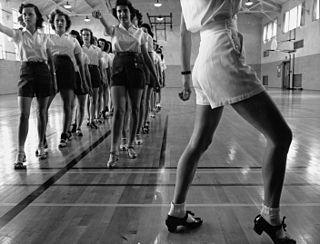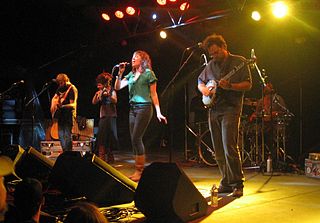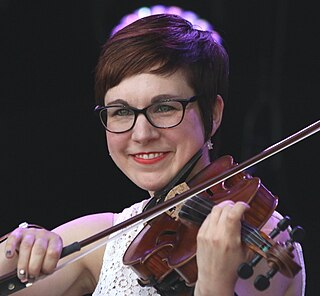
Tap dance is a form of dance that uses the sounds of tap shoes striking the floor as a form of percussion; it is often accompanied by music. Tap dancing can also be a cappella, with no musical accompaniment; the sound of the taps is its own music.

Bluegrass music is a genre of American roots music that developed in the 1940s in the Appalachian region of the United States. The genre derives its name from the band Bill Monroe and the Blue Grass Boys. Like mainstream country music, it largely developed out of old-time music. Unlike country, it is traditionally played exclusively on acoustic instruments from Africa and Europe. Bluegrass has roots in traditional North European music, such as Irish ballads and dance tunes, as well as African American genres like blues and jazz. It was further developed by musicians who played with Monroe, including 5-string banjo player Earl Scruggs and guitarist Lester Flatt. Bill Monroe once described bluegrass music as, "It's a part of Methodist, Holiness and Baptist traditions. It's blues and jazz, and it has a high lonesome sound."
The Wheatland Music Festival is a music and arts festival organized by the Wheatland Music Organization, a non-profit organization specializing in the preservation and presentation of traditional arts and music. Community outreach services include programming for Senior facilities and schools across mid-Michigan, year-round instrument lessons, scholarship programs, Jamborees, Traditional Dances, and Wheatscouts - a free program educating children through music, dance, storytelling, crafts and nature. Each year, the organization holds its annual Traditional Arts Weekend the weekend of Memorial Day, and its annual festival during the second weekend in September in the unincorporated community of Remus in the state of Michigan, in the United States. The first Wheatland Music Festival was held August 24, 1974.

Step dance is a generic term for dance styles in which footwork is considered to be the most important part of the dance and limb movements and styling are either restricted or considered irrelevant.

Old-time music is a genre of North American folk music. It developed along with various North American folk dances, such as square dancing, contra dance, clogging, and buck dancing. It is played on acoustic instruments, generally centering on a combination of fiddle and plucked string instruments, most often the banjo, guitar, and mandolin. Together, they form an ensemble called the string band, which along with the simple banjo–fiddle duet have historically been the most common configurations to play old-time music. The genre is considered a precursor to modern country music.

Cape Breton fiddling is a regional violin style which falls within the Celtic music idiom. The more predominant style in Cape Breton Island's fiddle music was brought to North America by Scottish immigrants during the Highland Clearances. These Scottish immigrants were primarily from Gaelic-speaking regions in the Scottish Highlands and the Outer Hebrides. Although fiddling has changed since this time in Scotland, it is widely held that the tradition of Scottish fiddle music has been better preserved in Cape Breton. While there is a similar tradition from the Irish-style fiddling, that style is overlooked as a result of the Scottish presence in the area.
Clogging, buck dancing, or flatfoot dancing is a type of folk dance practiced in the United States, in which the dancer's footwear is used percussively by striking the heel, the toe, or both against a floor or each other to create audible rhythms, usually to the downbeat with the heel keeping the rhythm. Clogging can be found at various Old-Time and Bluegrass Music festivals.

Appalachian music is the music of the region of Appalachia in the Eastern United States. Traditional Appalachian music is derived from various influences, including the ballads, hymns and fiddle music of the British Isles, and to a lesser extent the music of Continental Europe.

The Duhks were a Canadian folk fusion band, formed in 2002 in Winnipeg, Manitoba, Canada. Featuring banjo, fiddle, guitar, percussion, and vocals, The Duhks blended folk music together with various Canadian and American traditional styles, including soul, gospel, old-time country string, and zydeco. The band also commonly played traditional Irish dance music, integrating Latin-influenced percussion as well as often Celtic- and Cajun-influenced fiddle-playing.

Clog dancing is a form of step dance characterised by the wearing of inflexible, wooden soled clogs. Clog dancing developed into differing intricate forms both in Wales and also in the North of England. Welsh clog dancing mainly originates from various slate mines where workers would compete against each other during work breaks. Northern English traditional clog dancing originates from Lancashire, Yorkshire, County Durham, Northumberland and the Lake District.

April Verch is a Canadian fiddler, singer, and step dancer raised in the community of Rankin, Ontario, located approximately 15 kilometres (9.3 mi) southwest from Pembroke, Ontario. The youngest daughter of Ralph and Muriel Verch, April began step dancing at age three with her first step dance teachers, Buster and Pauline Brown, and began learning fiddle at age six from Pembroke fiddler Rob Dagenais, shortly after receiving her first violin as a birthday present. Throughout her childhood, April played both old time fiddle and classical violin, having competed and having won awards at fiddle contests inside and outside Ontario, as well as regularly performing with the Deep River Symphony Orchestra over that period. She also competed and won numerous awards for her step dancing in that time frame as well.
Sean-nós dance in America has its roots in Irish culture, but may be practiced differently from how it is danced in Ireland. When Irish people emigrated to America in great numbers during the early American Colonial period, or when escaping The Troubles in Ireland, they brought their dance culture with them. One of the many forms of Irish dance is sean-nós dance, which is an informal, spontaneous, solo form of dance. Sean-nós dance has both modified, and in turn been modified by, similar forms of traditional vernacular solo dance in America.

The Appalachian String Band Music Festival is a weeklong gathering of thousands of string band musicians and their friends from across the country and around the world, who each year since 1990 have assembled near the New River Gorge in West Virginia in late July/early August to celebrate the evolving tradition of old-time music and the community of people who keep it thriving by preserving and contributing to that tradition.

Riley Baugus is an American old-time guitarist, banjo player, fiddler, singer and instrument builder from North Carolina.
Leela and Ellie Grace are a duo of American singer/songwriters. They are sisters, the daughters of Paul and Win Grace. They perform a mixture of original compositions by both sisters, traditional folk and old time songs, and covers of songs by other contemporary folk songwriters.

Old timefiddle is the style of American fiddling found in old-time music. Old time fiddle tunes are derived from European folk dance forms such as the jig, reel, breakdown, schottische, waltz, two-step, and polka. When the fiddle is accompanied by banjo, guitar, mandolin, or other string instruments, the configuration is called a string band. The types of tunes found in old-time fiddling are called "fiddle tunes", even when played by instruments other than a fiddle.

Canadian fiddle is the aggregate body of tunes, styles and musicians engaging the traditional folk music of Canada on the fiddle. It is an integral extension of the Anglo-Celtic and Québécois French folk music tradition but has distinct features found only in the Western hemisphere.
Bluegrass fiddling is a distinctive style of American fiddle playing which is characterized by bold, bluesy improvisation, off-beat "chopping", and sophisticated use of both double-stops and old-time bowing patterns.
Canadian stepdance refers to several related forms of percussive stepdance in Canada with European origins including France, Ireland and Scotland. Canadian stepdancing involves percussive dancing to "Celtic" tunes, usually played by fiddle. Percussive sounds are created through a combination of foot movements such as heel taps, toe taps, and shuffles, all designed to accentuate the music. Canadian stepdance is normally danced in a small space with limited lateral movement. Upper-body postures in Canadian stepdancing are typically relaxed but upright, allowing occasional arm movements that flow with the rhythm of the dance, or hands on hips.
Robert Dotson (1923-2015) was a flatfoot dancer from Sugar Grove, North Carolina; he and his wife, Myrtle, were instrumental in keeping the tradition of flatfoot dancing styles of Western North Carolina alive, and they received the North Carolina Heritage Award in 1994. The couple, who grew up dancing in the same community, made a conscious decision and effort to keep alive the traditional flatfoot dance styles of western North Carolina, deliberately weaving the old-time flatfoot and buckdance steps into their dancing, even when many of their neighbors performed the latest clogging variations. They also hosted their own dances near their home in Sugar Grove.













